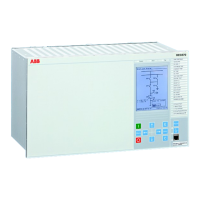16. Station communication
Overview
Each IED is provided with a communication interface,
enabling it to connect to one or many substation level
systems or equipment, either on the Substation Automation
(SA) bus or Substation Monitoring (SM) bus.
Following communication protocols are available:
• IEC 61850-8-1 communication protocol
• LON communication protocol
• SPA or IEC 60870-5-103 communication protocol
• DNP3.0 communication protocol
Theoretically, several protocols can be combined in the same
IED.
IEC 61850-8-1 communication protocol
The IED is equipped with single or double optical Ethernet
rear ports (order dependent) for IEC 61850-8-1 station bus
communication. The IEC 61850-8-1 communication is also
possible from the optical Ethernet front port. IEC 61850-8-1
protocol allows intelligent electrical devices (IEDs) from
different vendors to exchange information and simplifies
system engineering. Peer-to-peer communication according
to GOOSE is part of the standard. Disturbance files uploading
is provided.
Serial communication, LON
Existing stations with ABB station bus LON can be extended
with use of the optical LON interface. This allows full SA
functionality including peer-to-peer messaging and
cooperation between existing ABB IED's and the new IED
670.
SPA communication protocol
A single glass or plastic port is provided for the ABB SPA
protocol. This allows extensions of simple substation
automation systems but the main use is for Substation
Monitoring Systems SMS.
IEC 60870-5-103 communication protocol
A single glass or plastic port is provided for the
IEC60870-5-103 standard. This allows design of simple
substation automation systems including equipment from
different vendors. Disturbance files uploading is provided.
DNP3.0 communication protocol
An electrical RS485 and an optical Ethernet port is available
for the DNP3.0 communication. DNP3.0 Level 2
communication with unsolicited events, time synchronizing
and disturbance reporting is provided for communication to
RTUs, Gateways or HMI systems.
Multiple command and transmit
When 670 IED's are used in Substation Automation systems
with LON, SPA or IEC60870-5-103 communication protocols
the Event and Multiple Command function blocks are used as
the communication interface for vertical communication to
station HMI and gateway and as interface for horizontal peer-
to-peer communication (over LON only).
IEC 62439-3 Parallel Redundant Protocol
Redundant station bus communication according to IEC
62439-3 Edition 1 and IEC 62439-3 Edition 2 are available as
options in 670 series IEDs. IEC 62439-3 parallel redundant
protocol is an optional quantity and the selection is made at
ordering. Redundant station bus communication according to
IEC 62439-3 uses both port AB and port CD on the OEM
module.
Select IEC 62439-3 Edition 1 protocol at
the time of ordering when an existing
redundant station bus DuoDriver installation
is extended.
Select IEC 62439-3 Edition 2 protocol at
the time of ordering for new installations
with redundant station bus.
IEC 62439-3 Edition 1 is NOT compatible
with IEC 62439-3 Edition 2.
17. Remote communication
Analog and binary signal transfer to remote end
Three analog and eight binary signals can be exchanged
between two IEDs. This functionality is mainly used for the
line differential protection. However it can be used in other
products as well. An IED can communicate with up to 4
remote IEDs.
Binary signal transfer to remote end, 192 signals
If the communication channel is used for transfer of binary
signals only, up to 192 binary signals can be exchanged
between two IEDs. For example, this functionality can be
used to send information such as status of primary
switchgear apparatus or intertripping signals to the remote
IED. An IED can communicate with up to 4 remote IEDs.
Line data communication module, short and medium range
LDCM
The line data communication module (LDCM) is used for
communication between the IEDs situated at distances <110
km or from the IED to optical to electrical converter with G.
703 or G.703E1 interface located on a distances <3 km
away. The LDCM module sends and receives data, to and
from another LDCM module. The IEEE/ANSI C37.94 standard
format is used.
Galvanic interface G.703 resp G.703E1
The external galvanic data communication converter G.703/G.
703E1 makes an optical-to-galvanic conversion for
connection to a multiplexer. These units are designed for 64
kbit/s resp 2Mbit/s operation. The converter is delivered with
19” rack mounting accessories.
1MRK511232-BEN E
Pre-configured
Product version: 1.2
ABB 19

